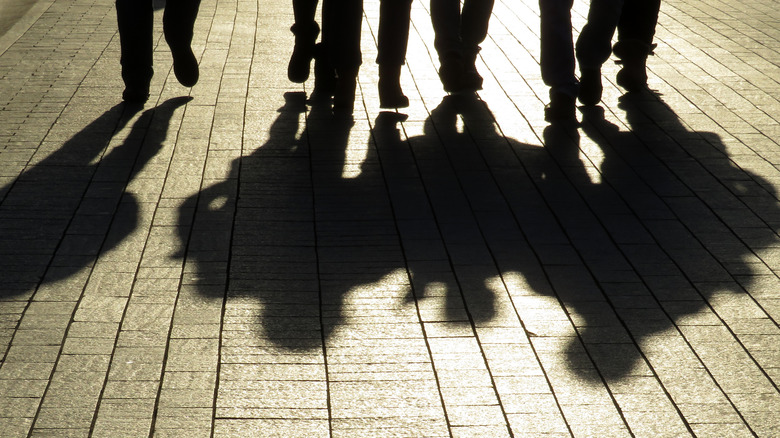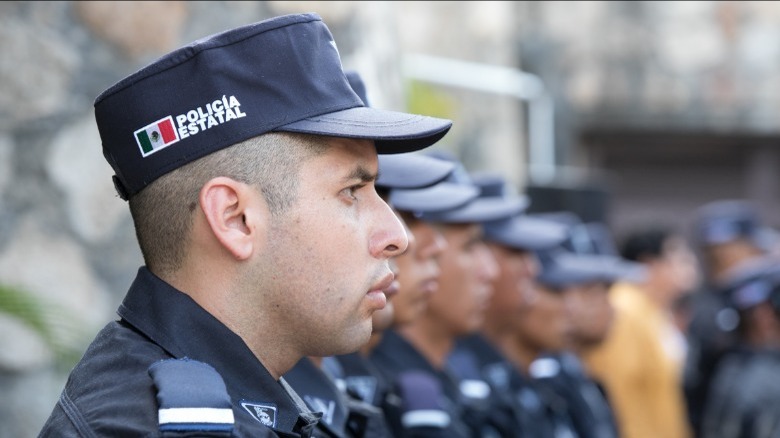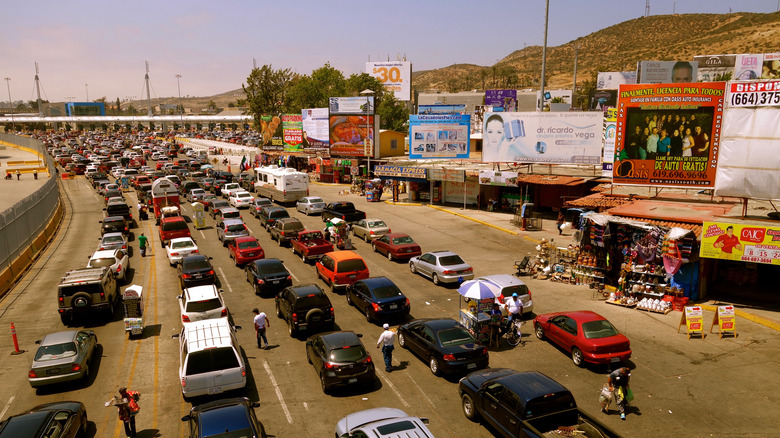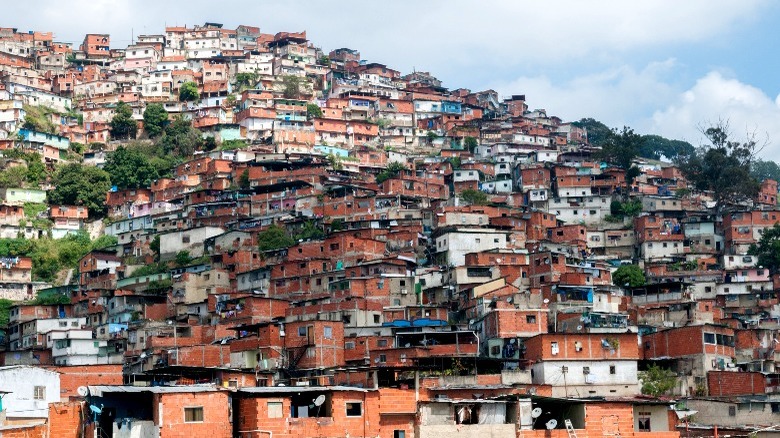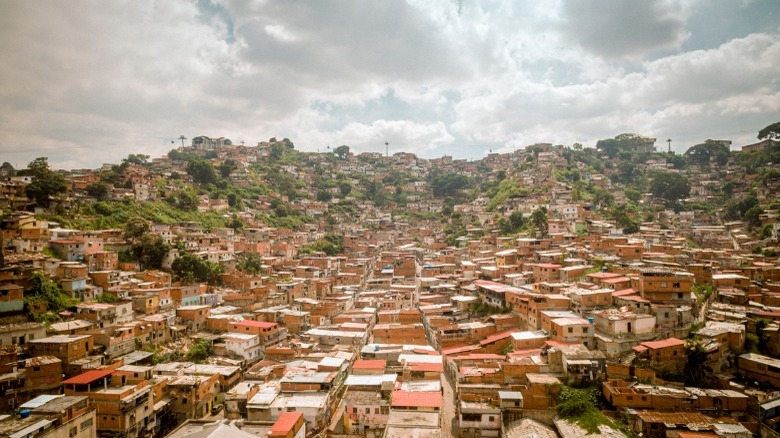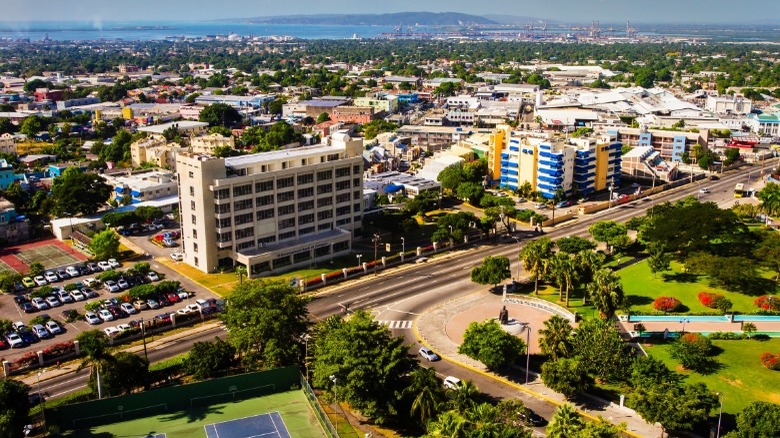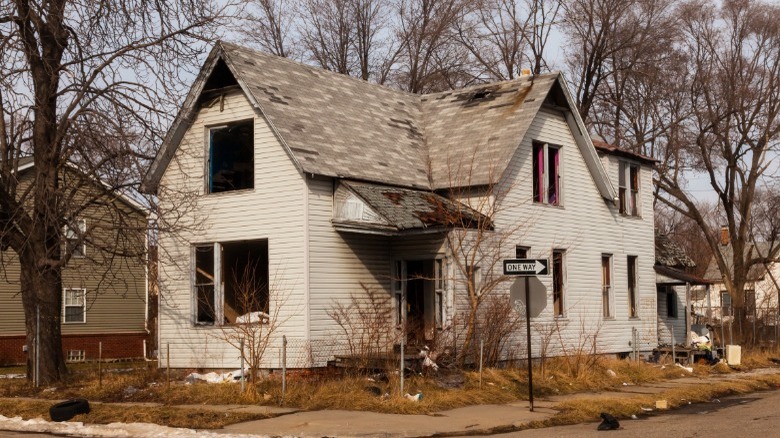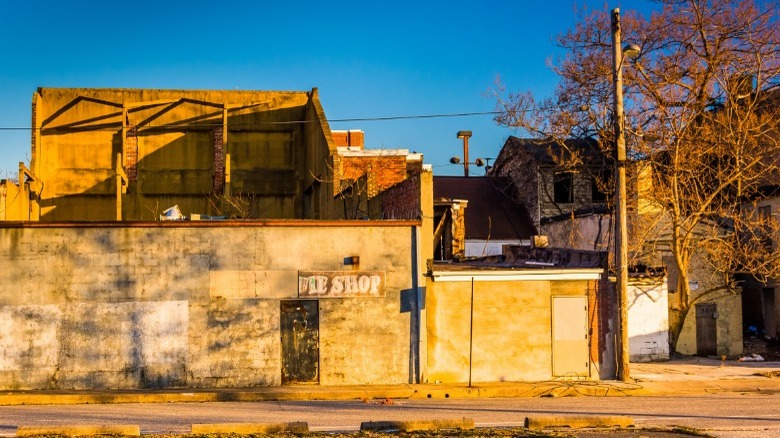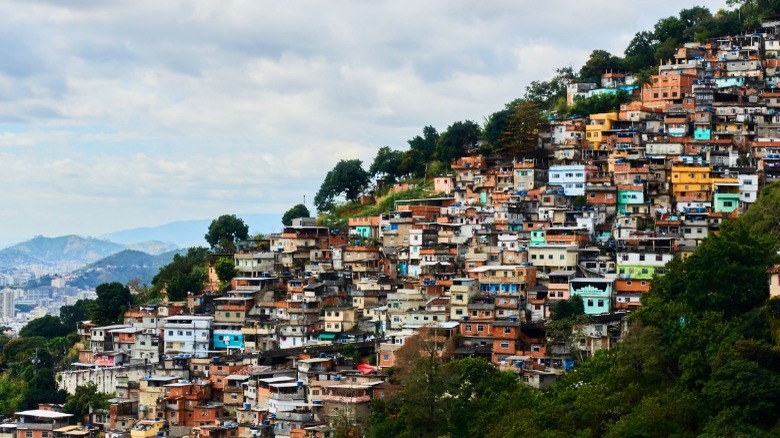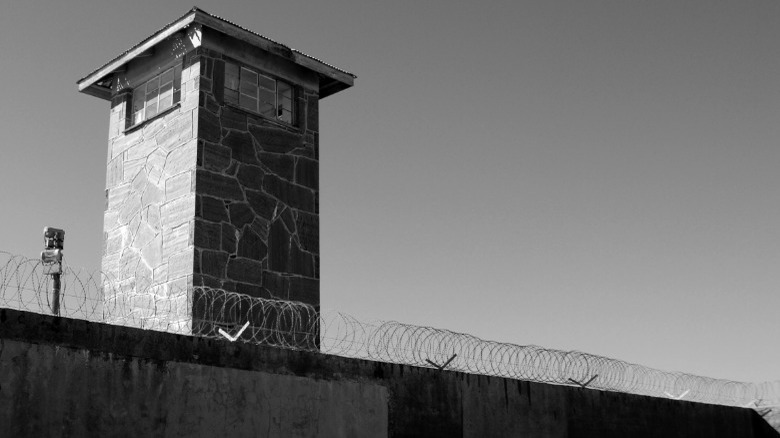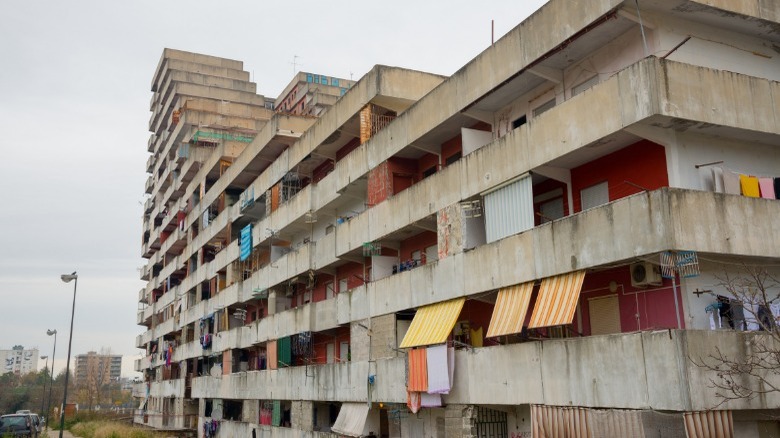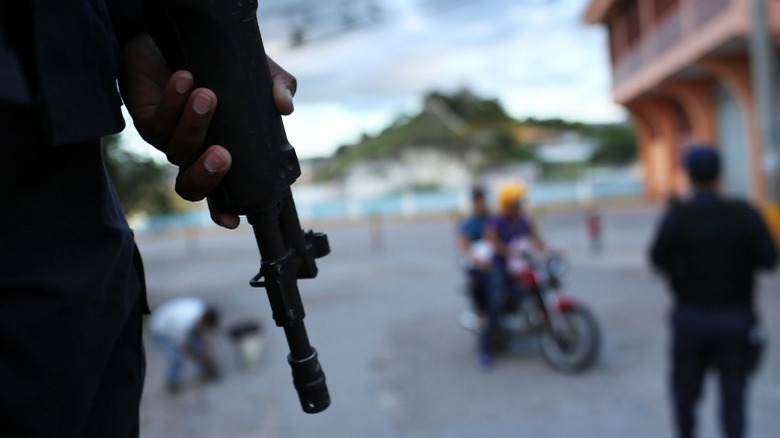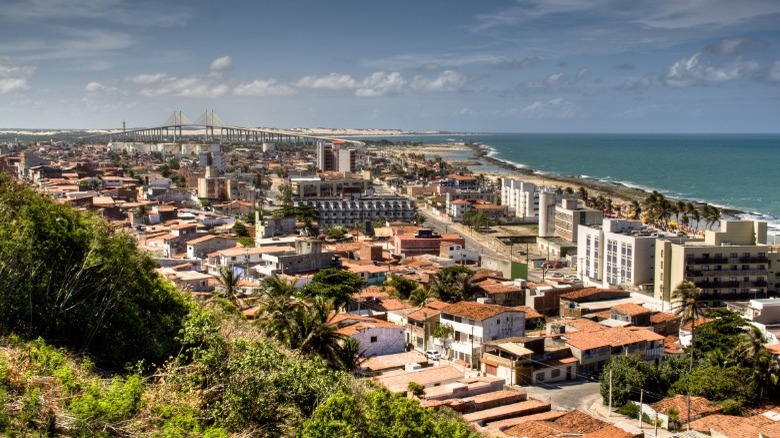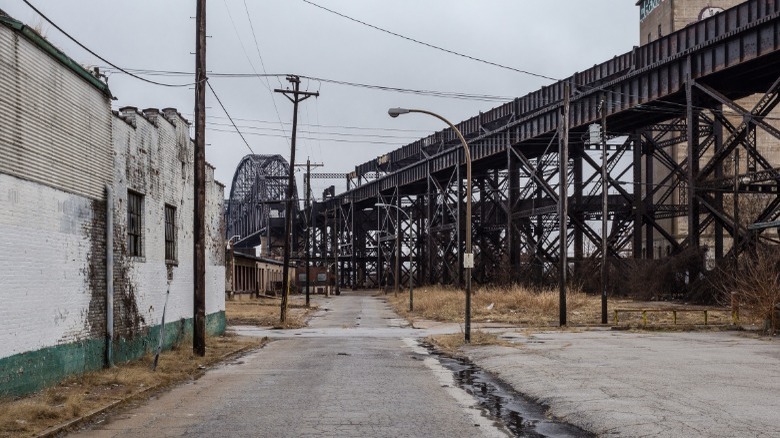The Most Dangerous Neighborhoods In The World
The world has never been a safer place than it is today. Yes, really — just ask Steven Pinker. Or read The Guardian, which reported a 70% decline in global poverty since the 1960s. This has corresponded with a decline in homicides across North America, Europe, Asia and Oceania, according to The Conversation.
However, this has not been true of Latin America, which has seen a 9% increase in violence since 1990. Drug wars and political instability have devastated cities across the region, producing some of the most dangerous neighborhoods in the world. These are blocks and streets where all manner of crime is rife, especially lethal violence.
Still, pockets of violence persist in not only Latin America but all parts of the world, including the United States. So, for the dark tourists among you, here is a breakdown of the most dangerous neighborhoods in the world.
Renacimiento — Acapulco, Mexico
Frank Sinatra sang of "Acapulco Bay" in his glamorous 1958 hit single "Come Fly With Me," which captured the zeitgeist of the jet set age. Thirty years later, in 1988, Motown band Four Tops took it a step further with "Loco in Acapulco," a poppy tribute to what was then Mexico's premier resort town. Alas, much has changed since Sinatra's heyday. And to go "loco" in Acapulco today is more likely to involve pistols and submachine guns rather than too many margaritas. According to The Guardian, Acapulco was the most violent city in Mexico from 2012 to 2016. Shockingly, the first six months of 2016 saw 461 murders in the city, many of the victims being security guards, taxi drivers and small business owners.
The violence has only continued during the last five years. In 2020, a Statista report found that Acapulco was the third most violent city in the world. A feature in The Independent detailed how much of the gang violence is centered in Renacimiento, where taxi drivers pay large protection fees to armed gangsters. The drivers will know what happens if they don't pay. If they're lucky, their taxis will be burned or joyridden to destruction. But it is not unlikely that they will simply be shot to death. After all, this is a neighborhood with roving assassins who carry out "well-orchestrated, military-style attacks." Police have managed to eliminate several gang leaders, but the danger remains acute for residents, who yearn for the days of packed tourist beaches.
Camino Verde, Zona Norte, and Sanchez Taboada — Tijuana, Mexico
Acapulco is in a bad way, but Tijuana is even worse. Situated on the border with the United States, Tijuana consistently ranks among the most violent cities in the world. According to the Citizen Council for Public Safety and Criminal Justice, Tijuana was the most violent city in the world in 2018, and the bloodshed is only increasing. Fox 5 San Diego reported in July 2021 that almost six people a day are murdered in the city.
The killings are spread throughout the city, but there are some hotspots. A report by KQED quoted Officer Alfredo Rodriguez, "This whole area: Sánchez Taboada, Reforma, Camino Verde. This is where the killings happen." This is supported by physicist and Tijuana native Victor Onofore, who used data to map the most violent areas of his city.
Onofore found that the neighborhoods of Camino Verde, Zona Norte, and Sanchez Taboada were the three most violent areas, describing Camino Verde and Sanchez Taboada as, "One big zone with very high homicides rates." Onofore spent 18 years in the city, including in the Sanchez Taboada neighborhood. His account of life here is moving: "Violence becomes normal, expected ... if you hear a gunshot near your house you don't call the police because they are, sometimes, more dangerous than the criminals." The situation may feel hopeless for the residents of Tijuana, but organizations such as the Wilson Center have listed ways to reduce violence in Mexico.
Petare — Caracas, Venezeula
Petare is a slum in eastern Caracas that was founded in 1621 by Spanish conquistadors. Today, in its 400th year, Petare is one of the most dangerous neighborhoods in Caracas, which is among the most violent cities in the world. According to The Journal, crime spiked in Venezuela during Hugo Chavez's government, which "viewed crime as something rooted in political factors and failed to address it with a dedicated law-enforcement effort."
An account in the Caracas Chronicles described Petare in the early months of the COVID-19 pandemic: "State security forces occupied the neighborhood searching for the gang leader and master of the turf. For days, shots echoed through the eastern part of the valley of an otherwise quiet city." It is telling that violence is one of the few marks of Petare life that continued during the worst days of the pandemic. After all, this is a slum — or "barrio" — where socializing at night risks theft, assault, or murder. This is why raves and parties occur during the day rather than at night, according to Alejandro Velasco, a historian of Latin America at New York University. Velasco added that if people do go out at night, "They keep bodyguards with them, which just increases the general presence of weapons." This abundance of weaponry, combined with state forces and a legal system that the public does not trust, creates what Council on Hemispheric Affairs terms a "violence trap."
Catia — Caracas, Venezuela
Like in Petare, gang violence is rife in the alleys of Catia, a slum in Caracas's western area. According to a Time article, up to a third of the city's murders occurred in Catia during Hugo Chavez's presidency. Again, the problem is gang violence, which continues to blight the neighborhood.
In an interview for a University of Sussex research paper, a Catia resident described the "malandro" gang culture: "It's a fashion. Just like lighting a cigarette, or having a beer ... it's in the atmosphere." The young "malandro" boys of Catia have to remain guarded — or "activo" — at all times, keeping an eye on every passerby. Venturing from their street corner invites serious danger, as entering another gang's area could result in gunfire.
However, there has been a recent dip in violence, not because of effective policing or shifting attitudes, but because of the sheer price of guns and ammunition. A report in The Independent found that bullets can cost $1 each, which is a high price even for a hardened gangster called "El Negrito." "If you empty your clip, you're shooting off $15... [and if] you lose your pistol or the police take it and you're throwing away $800," he said. This is perhaps the only silver lining of Venezuela's disastrous economy, which saw an inflation rate of 1 million percent in 2019.
Trench Town — Kingston, Jamaica
Kingston, Jamaica, has long ranked amongst the most dangerous cities in the world. According to Business Insider, Kingston was the world's 19th most violent city in 2018. Like other dangerous cities in the region, much of crime and violence stems from gang warfare. OSAC reported that Jamaica's police force is understaffed and has limited resources, causing the country's crime rate to be three times higher than the Latin American and Caribbean average.
In Kingston, gang activity is concentrated in the neighborhood of Trench Town, which was put under a curfew in January 2021 after a spate of shootings, according to the Jamaica Observer. Six months later, on June 13, a drive-by shooting killed a 16-year-old girl and a 23-year-old man, according to The Gleaner. It is all part of life in Trench Town, which is a neighborhood so fraught with danger that the local U.S. Embassy prohibits its staff from visiting the area.
The Kingston Western Police Division have reported an 11% increase in murder and a 25% increase in shootings, as the "Socks" and "Brooklyn" gangs continue to wage war on each other. As with other problem neighborhoods, Trench Town residents complain of police and security forces turning a blind eye to criminals and gang members.
Fiskhorn — Detroit, Michigan
Once one of America's most prosperous cities, Detroit has since become a byword for violence and poverty. Detroit hit rock bottom when it filed for bankruptcy in 2013. According to the Detroit Free Press, the city's population has declined for seven straight decades as violence continues to blight the area.
AreaVibes found that the most dangerous part of Motor City was "Fishkorn," where violent crime is 1409% greater than the national average. Note that AreaVibes called it "Fishkorn" rather than "Fiskhorn," which is the actual name used by locals. This misspelling arose after Google Maps used an erroneous 2002 map. It must be perplexing and even annoying for Detroit residents, but they have bigger problems on their minds. In Fiskhorn, one in eight people will be the victim of a crime, according to FBI data for the 2019 calendar year. The neighborhood falls within the Detroit Police Department's Precinct 2, which reported a homicide rate of 5.87 per 10,000, placing it among Detroit's most dangerous precincts.
Middle East — Baltimore, Maryland
Baltimore is another American city that has become synonymous with danger and dysfunction. The city's decrepit rowhouses became icons of social distress in the lauded HBO show, "The Wire." One of the shooting locations for the show was Middle East, which was renamed East Baltimore Development Initiative (EBDI) in 2002, according to The Guardian. Unsurprisingly, locals still refer to it by its old name. According to the John Hopkins Newsletter, EBDI has been "the most drastic urban redevelopment initiative in recent American history."
However, crime remains a serious issue in Middle East. AreaVibes reported that the area, which it terms "Hopkins-Middle East," has a violent crime rate 858% higher than the national average. Year-on-year crime has seen a 3% reduction, but residents still have a one in 10 chance of being a victim of crime, which is 340% higher than the U.S. average. This dangerous level of crime and violence corresponds with household incomes, house prices, and graduation rates that are far below the Maryland average.
According to the Baltimore Sun, the city police launched a $200,000 recruitment campaign with the slogan, "The greatest comeback story in America." To Baltimoreans, whose city Politico described as "deadliest big city in America," that sentiment may ring hollow.
Complexo de Alemao — Rio de Janeiro, Brazil
According to RioOnWatch, a community site that reports on Rio de Janeiro, a shootout happens every 30 hours in the neighborhood of Complexo do Alemao, one of the city's largest favelas. Then there are the gunshots, which occur at any time of the day. Every resident has their own story and perspective. In an interview with RioOnWatch, a group at a bar agree that the third shootout of the day normally occurs at 4 p.m. A passing garbageman notes an empty water tank at the bar — refilling it would be futile because of the bullet holes that riddle it. It's reflective of a neighborhood in which "guerilla warfare" is an everyday occurrence.
Complexo do Alemao is a microcosm of a city that continues to struggle with intense gang violence. In May 2021, the most lethal police raid in Rio's history occurred in Jacarezinho, resulting in the death of 28 people, including a police officer. According to journalist Raphael Tsavkko Garcia, this brutally heavy-handed approach will cause there to be "less chance for Brazil to break this cycle of violence."
Cape Flats — Cape Town, South Africa
Cape Town, South Africa, continues to struggle with serious gang violence, especially in the Cape Flats area, according to The Times. The Cape Flats are a collection of densely populated townships that are terrorized by gangs, such as the Americans, Hard Livings, Fancy Boys, and Dixie Boys, a Guardian report found. These gangs are so dangerous that troops monitor them in armed convoys. Guy Lamb, director of the Safety and Violence Initiative at the University of Cape Town, said that gang violence was greatly escalated when former police officer Chris Prinsloo supplied gangs with around 2,500 firearms, which emboldened a slew of violent criminals in the Cape Flats area.
This influx of weaponry has caused 10 years of bloodshed that shows no signs of abating. In March 2021, the Mail and Guardian reported that gun violence killed 14 people in the Cape Flats and "seriously injured" a further 10. Three months later, a damning article in Cape Town Etc detailed 12 tragic murders that occurred on June 12 – 15 in Cape Flats, including two 3-year-old children, a pair of security guards, and a 24-year-old man killed by a stray bullet. The Conversation estimates that some 100,000 people operate in around 130 gangs that fight each other for money, territory, and influence.
Scampia — Naples, Italy
Naples, Italy, is a far cry from the violence of Latin America, but its Scampia neighborhood is still dangerous. According to Roberto Saviano, the author of "Gomorra," Scampia has been Europe's "largest drug-dealing hotspot" for years. Also, The Conversation notes that the area has seen the rise of "baby gangs," who are often young men committing "gratuitously violent" crimes to catch the attention of senior Camorra mobsters. The Camorra is a Neapolitan organized crime group and, according to Wanted in Rome, is the oldest mob group in Italy. They spent much of the 20th century as overlords of the Naples criminal underworld. Yet as the old bosses are either murdered or incarcerated, a report in The Guardian suggested that the "baby gangs" have destabilized this order.
These kids, who carry 9 mm handguns by their mid-teens, are the consequences of Campania's unemployment rate, which Statista measured at 18.7%. This aimlessness is symbolized by the decay of Scampia, which was dominated by Le Vele, a vast network of brutalist apartments built from 1962 to 1975. These structures are currently being demolished or updated, but the presence of the Camorra or the "baby gangs" will be much harder to eradicate.
Chamelecon — San Pedro Sula, Honduras
According to the New York Times, the Chamelecon area of San Pedro Sula is a slum that's fought over by two of the country's most powerful gangs, MS-13 (Mara Salvatrucha) and Mara 18 (MS-18). The violence in Chamelecon causes San Pedro Sula to be among the most violent cities in the world, according to Statista. Maryknoll Magazine reported that over 100,000 people live in the hurricane-battered barrio, which is widely referred to the "murder capital of Honduras" and sometimes all of Central America.
People are killed because of familiar urban problems: drugs, human trafficking, and protection rackets. Journalists from PIX11 visited the neighborhood, which at the time was guarded by military personnel that refer to Chamelecon as a "conflict zone." Inside, they found a concrete mass of desolate streets and barbed wire. The neighborhood became this way after a 2004 bus massacre that killed 28 people, mostly women and children, according to a CBS report. This appalling act of gang violence caused an exodus from Chamelecon, which was subsequently taken over by criminals, whose stories make for sobering reading. Mother Jones interviewed a 34-year-old hitman who confessed to killing 17 people, which would rank him among the worst mass shooters and serial killers. Unrepentant, he said he'd continue to kill to earn a living.
Felipe Camarao — Natal, Brazil
Natal, the capital of the Brazilian state of Rio Grande do Norte, has become one of the most violent cities in the country, according to Statista. The International Journal of Safety and Security in Tourism/Hospitality found that the Felipe Camarao neighborhood accounted for 26.99% of the homicides in Natal's Western Zone, which is the city's most dangerous area. Some 166 murders were recorded in the neighborhood between 2015 – 2017, and there has been little sign of a let up.
In 2021, G1 reported the senseless murder of a 39-year-old man during his morning walk to work. No suspects were arrested after Josenildo de Souza Pinto was shot eight times on Rua Santa Maria Madalena, a tired and dusty thoroughfare in Felipe Camarao's eastern area. It was another gratuitous act of violence in a city where the murder rate is 102 people per 100,000. Even the local prison isn't safe from mass violence. In 2017, a barbaric riot erupted in Alcaçuz prison that killed at least 30 inmates, some of whom were burned and decapitated, according to The Guardian.
Peabody-Darst-Webbe — St Louis, Missouri
St. Louis, Missouri, joins Detroit as one of the most dangerous cities in the United States. In November 2020, CBS News found that St. Louis was the second most dangerous city in the nation. According to AreaVibes, the city's most dangerous neighborhood is Peabody-Darst-Webbe, which has a rate of violence 1189% higher than the national average.
Life is cheap in this neighborhood, which is just a seven-minute drive from the famous Gateway Arch, according to Google Maps. In June 2019, a shooting occurred near a vehicle with four children and two women. One of the women was struck by a bullet, which she fortunately survived, according to KMOV4. In August 2021, the Kansas City Star reported the death of a man found with a bullet wound to his upper chest. These local headlines come and go in St. Louis, where homicide has seen a 40% increase in 2021, according to KMOV St. Louis.
